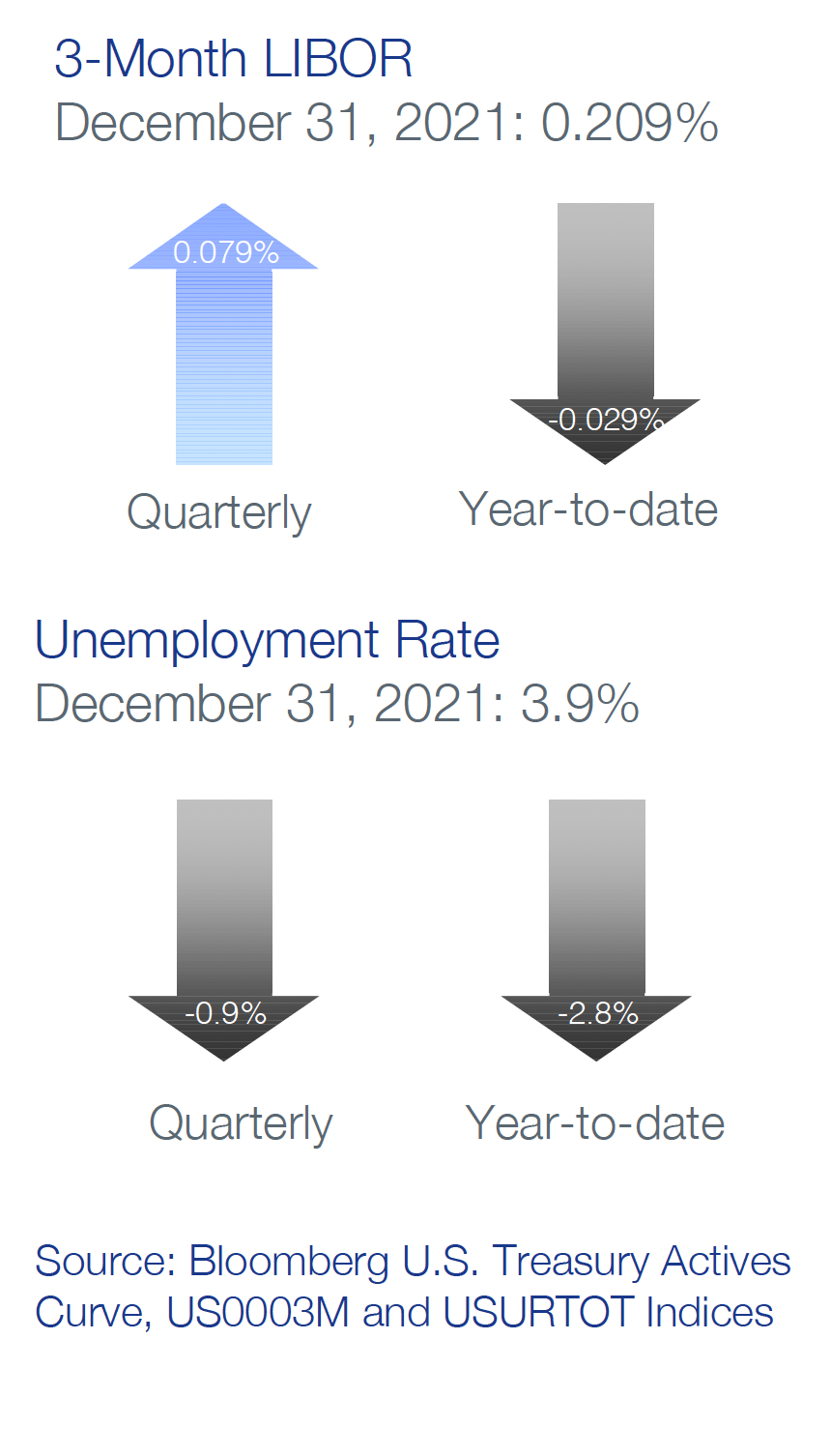Quarterly Portfolio Manager Commentary
December 31, 2021

Cash Management Portfolios
What market conditions had a direct impact on the bond market this quarter?
Market movements were influenced by rising inflation levels and expectations the Federal Reserve (Fed) will more aggressively remove monetary policy accommodation. These factors pushed yield curve levels higher, resulting in negative performance for most fixed income indexes.
Economic Activity – U.S. Gross Domestic Product (GDP) rebounded in the fourth quarter (Q4), with growth estimates in the 6.0% range after the third quarter’s 2.3% pace. Consumer spending continues to outstrip supply and production capacity, aggravating inflation pressures. Employment conditions remain historically tight, with November U.S. Job Openings standing at 10.439 million open positions vs. December’s Total Unemployed Workers in the Labor Force of 6.319 million. Further emphasizing strong labor demand, the U3 Unemployment rate fell to 3.9% in December and Average Hourly Earnings rose a healthy 4.7% in 2021. Recent Non-farm Payrolls (NFP) readings have diverged from other employment indicators, adding 199,000 jobs in December and 1.096 million in the quarter vs. Household Survey gains of 651,000 and 2.169 million, respectively. NFP are down 3.572 million jobs since February 2020, despite a full recovery of GDP to pre-COVID levels and low unemployment rates. The headline Consumer Price Index (CPI) was 7.0% for 2021, with CPI ex. food and energy rising 5.5% year-over-year (YoY). The Fed’s preferred inflation index – the PCE Core Deflator Index – increased 4.7% YoY through November, the highest reading since 1989. Given the persistence of supply chain issues and wage and price pressures, the Fed has stopped describing inflation trends as transitory.
Monetary Policy – The Fed accelerated the wind down of asset purchases at the December 15th meeting, doubling the tapering pace to $30 billion per month and targeting March for completion. The minutes from the December 15th meeting suggested Fed officials believe the dual goals of average inflation of 2% and maximum employment have been achieved, clearing the way for a potential rate hike as early as the March 16th meeting. The current Fed Dot Plot predicts three rate hikes in 2022 followed by three more in 2023. Fed funds futures predict a similar path for policy rates. Usage of the Federal Reserve New York’s Reverse Repo Program reached a record high of $1.904 trillion at year-end and averaged $1.494 trillion during the quarter, a clear sign of excess liquidity in the financial system as Fed asset purchases are simply being recycled back onto the Fed’s balance sheet. Given the excess cash in the system, policymakers have signaled balance sheet reduction – quantitative tightening – will occur at some point in 2022.
Fiscal Policy – President Biden’s “Build Back Better” plan stalled in Congress, but the Administration was able to pass a $1.2 trillion infrastructure bill in November. While passing further COVID-related stimulus is unlikely, government spending is still expected to grow 1.4% in 2022 and continue contributing to GDP growth. Importantly for financial markets, the Federal debt ceiling limit was raised by $2.5 trillion in December, which is enough borrowing capacity to potentially fund U.S. Treasury borrowing into early 2023.
Credit Markets – Higher inflation numbers and growing expectations for Fed rate hikes pushed U.S. Treasury yields higher. Credit markets continued to experience strong primary and secondary market liquidity and high investor demand for yield. Very short deposit, money market fund and T-Bill yields remained near zero, where they are likely to remain until the first Fed rate hike.
Yield Curve Shift
|
U.S. Treasury Curve |
Yield Curve 09/30/2021 |
Yield Curve 12/31/2021 |
Change (bps)* |
|---|---|---|---|
|
3 Month |
0.033% |
0.030% |
-0.3 |
|
1 Year |
0.068% |
0.376% |
30.8 |
|
2 Year |
0.276% |
0.732% |
45.6 |
|
3 Year |
0.508% |
0.957% |
44.9 |
|
5 Year |
0.965% |
1.263% |
29.8 |
|
10 Year |
1.487% |
1.510% |
2.3 |
Yield curve levels rose meaningfully in the quarter on surging inflation data and growing expectations for multiple Fed rate hikes in 2022. Given their maturity horizon, two- and three-year yields were most impacted by the increased probability of rate hikes. Ten-year yields, which are more influenced by inflation expectations than Fed policy, barely budged in the quarter, suggesting markets expect inflation levels to ease over the longer run.
The three-month to ten-year portion of the yield curve steepened a mere 2.6 basis points (bps) to 148 bps. Three-month yields should move higher as the T-Bill issuance rises in Q1 2022 and Fed rate hikes begin to get priced into the T-Bills rolling three-month horizon. We expect this portion of the curve to flatten as short yields jump on more frequent Fed rate hikes with longer rates rising to a lesser degree as inflation levels rollover later in 2022.
Duration Relative Performance

*Duration estimate is as of 12/31/2021
Q4 2021 U.S. Treasury performance played out as expected, with longer duration strategies more adversely impacted by rising rates. Negative Treasury performance was exacerbated by the low coupon levels of the indexes, which offered minimal income protection against declining bond prices.
Credit Spread Changes
|
ICE BofA Index |
OAS* (bps) 09/30/2021 |
OAS* (bps) 12/31/2021 |
Change (bps) |
|---|---|---|---|
|
1-3 Year U.S. Agency Index |
-1 |
-3 |
-2 |
|
1-3 Year AAA U.S. Corporate and Yankees |
7 |
6 |
-1 |
|
1-3 Year AA U.S. Corporate and Yankees |
15 |
19 |
4 |
|
1-3 Year A U.S. Corporate and Yankees |
29 |
37 |
8 |
|
1-3 Year BBB U.S. Corporate and Yankees |
56 |
70 |
14 |
|
0-3 Year AAA U.S. Fixed-Rate ABS |
27 |
36 |
9 |
*Option-Adjusted Spread (OAS) measures the spread of a fixed-income instrument against the risk-free rate of return. U.S. Treasury securities generally represent the risk-free rate.
Corporate and Asset-Backed Security (ABS) credit spreads widened in the quarter, driven by shrinking year-end dealer balance sheets, expectations for reduced central bank support, rising yield curve levels and concerns over surging COVID infection rates. Demand for credit remains strong, bolstered by the generally solid economic outlook and higher all-in corporate yields. Outperformance in the agency space vs. U.S. Treasuries was probably impacted by concerns over the Federal debt ceiling in the quarter. Negative agency spreads are unsustainable and reduce the attractiveness of the sector.
Credit Sector Relative Performance of ICE BofA Indexes

*AAA-A Corporate index underperformed the Treasury index by 2.3 bps in the quarter.
AAA-A Corporate index underperformed the BBB Corporate index by 5.0 bps in the quarter.
U.S. Financials underperformed U.S. Non-Financials by 7.9 bps in the quarter.
Given the significant moves in both yield curve and credit spread levels, the relative performance parity among various sectors was surprising. The uniformity of returns was partially due to the indices’ low coupon and credit spread levels, implying the positive effect of coupon income was swamped by rising yield curve levels, particularly in the two- and three-year portion of the curve.
What strategic moves were made and why?
Taxable Portfolios – Major upward moves in the U.S. Treasury yield curve resulted in negative returns for most fixed income portfolios, as the negative price action from higher rates overwhelmed the limited coupon income in five-year and less portfolios. As expected, portfolio duration levels played a major role in relative performance, with shorter strategies outperforming their longer-term counterparts. Relative sector performance was in a reasonably tight band. BBB to AA credit spreads widened in the quarter, although BBB indexes slightly outperformed AAA-A indexes due to higher coupon income returns. Public credit rating agency downgrades were infrequent in the quarter and no individual issuer in our approved universe suffered meaningful credit deterioration. Demand for yield and general market liquidity remained strong in the quarter, although year-end dealer balance sheet pressures limited bond market activity toward the latter-half of December.
Tax Exempt and Tax-Efficient Portfolios – As other fixed-income sectors reacted to prospects for more aggressive Fed activity with sharp moves higher in rates, the response from municipal bonds was much more muted. Tax-exempt securities with three-year maturities posted only a modest increase (+11 bps) in absolute yields. Technicals have remained strong, driven by steady flows into municipal bond funds. This demand vs. supply imbalance is most evident in the short end of the curve (1-3 year maturities), where relative ratios vs. Treasury securities fell below 40%. These low ratios may be encouraging some investors to look to taxable municipals in search of better value. We note the spreads on these securities have indeed compressed further from already tight levels. As an example, a two-year taxable muni now offers a mere five to 10 bps of incremental yield over Treasuries. The current market conditions and valuations are not providing much opportunity or incentive to add municipals and thus our participation has been limited.
How are you planning on positioning portfolios going forward?
Taxable Portfolios – The jump in yields has flipped unrealized gain positions into unrealized loss positions for many fixed income portfolios. We encourage investors, to focus on the opportunity to increase portfolio income levels through the re-investment of portfolio cash flows into higher-yielding debt, rather than focusing on unrealized losses, particularly if there is no need to sell these positions. Yield curve levels are likely to keep rising as the yield curve prices in a faster pace for Fed rate hikes. As a result, we are targeting portfolio duration around 90 – 95% of benchmark duration for most of our strategies, adding small bites of duration and yield along the way. Our outlook for solid U.S. GDP growth and the minor normalization of credit spreads bolsters the case for continued overweight to corporate, bank and ABS debt. Agency securities are rich compared to comparable duration U.S. Treasuries and we continue to de-emphasize agency bullet debt. Yields on very short portfolios (ex: money fund-like strategies, short T-Bill ladders) will remain low until the Fed implements rate hikes.
Tax Exempt and Tax-Efficient Portfolios – In the first two weeks of the new year, we have seen some lift to tax-exempt rates with front-end (1-3 year) yields 20-25 bps higher. It seems likely 2022 will bring opportunities to add fixed-rate investments at more reasonable levels. We will continually evaluate these yields vs. the expected Fed funds rate path to determine breakeven values. In a rising rate environment, a mix of fixed and variable-rate investments will be prudent and appropriate to maximize income. For tax-efficient portfolios, corporate bonds will likely remain the favored sector. We have noted some recent improvement in municipal relative ratios and there is certainly room for these levels to trend a bit higher. However, we don’t currently expect a big enough move that would incent us to redirect allocations toward municipals. While not a base-case outcome – a reversal of municipal fund flows tied to either a general allocation out of fixed income or a big stock market decline, is one potential catalyst which may change that view.
Sources
Bloomberg C1A0, CY11, CY21, CY31, G1P0, ICE Bond, JOLTTOTL, NFP TCH, PCE CYOY, US0003M, USUETOT and USURTOT Indices
Bloomberg, U.S. December Employment Situation: Statistical Summary, Chris Middleton
Bloomberg, U.S. Economic Forecast
Bloomberg, U.S. Treasury Actives Curve


